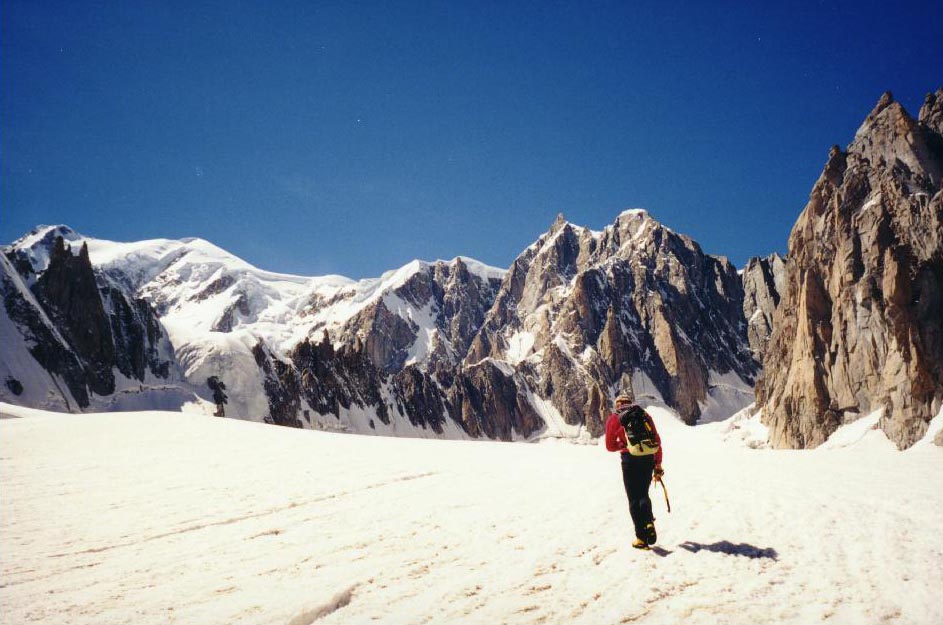 Hiking up to the Fourche Hut (Click on Picture for larger version)
Hiking up to the Fourche Hut (Click on Picture for larger version) La Minarete: S.E. Spur
Mont Blanc du Tacul: Triangle Face, Chere Couloir
Tour Ronde: N. Face
Aiguille du Midi: S. Face (Rebuffat)
Mount Maudit: Kuffner ( also "Frontier" or "tour ronde") Ridge
Guidebook references to these climbs:
Mont Blanc Massif: the 100 Finest Routes Gaston Rebuffat
Minaret pg. 152 (#60); Tour Ronde pg. 98 (#35); Midi S. Face pg 142 (#55); Mt. Maudit pg. 130 (#50) ("tour ronde ridge)
Mont Blanc Massif: Selected Climbs (2 volumes) Lindsay Griffin
Minaret Vol II pg. 222; Triangle Chere Couloir Vol I pg. 118; Tour Ronde Vol I pg. 132;
Midi S. Face Vol II pg. 34; Mt. Maudit Vol I pg 101
I arrived in Chamonix on the last day of August, and headed up to try the Kuffner (or Frontier) Ridge on Mount Maudit the next day. I had been interested in the Kuffner for some time. The Rebuffat book spoke very highly of the route's position and situations, and the Griffin guide also referred to it as one of the best ridge climbs in the range. Another plus was that the route was relatively free of objective dangers. I had several books with pictures of the route, and these added to my interest in climbing it. It is a long mixed route, rated "D" and about 800 meters high. My guide for the Kuffner was Francis, who had taken me up the Arete de Cosmiques in nasty weather two years earlier. He warned me that it might not be a good idea to head up on such a long, high altitude climb right off of the airplane, but I felt sure that I would have no trouble with the route. I had been working out about 2 hours a day, 5 days a week since Christmas, and was confident that my conditioning would be sufficient. We headed off a little after lunch time for the Fourche bivouac hut, which sits low on the Frontier ridge right at the start of the Kuffner route. A pleasant and scenic ride up the Aiguille de Midi tram, and then across on the cable car to Point Helbronner and the Italian side began our trip, then we began crossing the glaciers on our way to the Fourche hut. The Fourche hut is a small hut perched precariously on the Frontier ridge, with a rickety balcony from which you can look down into the great wild cirque of Mount Maudit. The view is beautiful and compelling. The hut has space for about ten people and is quite Spartan, with no electricity, water, etc. It also has no toilet facilities, and as a result is surrounded by mounds of fecal matter. They really needed a solar toilet here, like the one on the lower saddle on the Grand Teton.
 Hiking up to the Fourche Hut (Click on Picture for larger version)
Hiking up to the Fourche Hut (Click on Picture for larger version) Francis and I spent the next day cragging at a nearby limestone outcropping, climbing bolted sport routes. I climbed reasonably well, and finished feeling a little better about my abilities.
The next day, I was off to climb the S.E. spur of Le Minaret, a V+, A1, TD route on a beautiful granite pinnacle in the Argentiere basin. My guide for this venture was Pierre, a friend of Francis who was subbing due to some conflicts Francis had. Pierre was very congenial and a lot of fun to talk to. We took the cable cars up to the top of the Grand Montets station, and then hiked down across the glacier to the Argentiere hut. I was worried about a repeat of my miserable physical performance on the Kuffner, but on the hike in to the Argentiere hut, I felt much stronger and more comfortable than I had before. The Argentiere hut is large and comfortable, with amazing views of the huge north walls of Les Courtes, Les Droits, and the Aiguille Verte. The hut keeper was also very pleasant and a very good cook. Dinner was excellent and plentiful and I went to bed happy, although a bit worried that I would become debilitated like before. When we woke up before dawn, and ate breakfast, I was quite scared and worried about how I would perform. When we began hiking up the steep trail to the Minaret, I kept waiting for the shortness of breath and dizziness that had incapacitated me two days earlier. It never came, however, and I found that I could easily keep up with Pierre's steady gait. I began to feel much more optimistic, and by the time we reached the base of the Minaret, I was very excited to begin the climb.
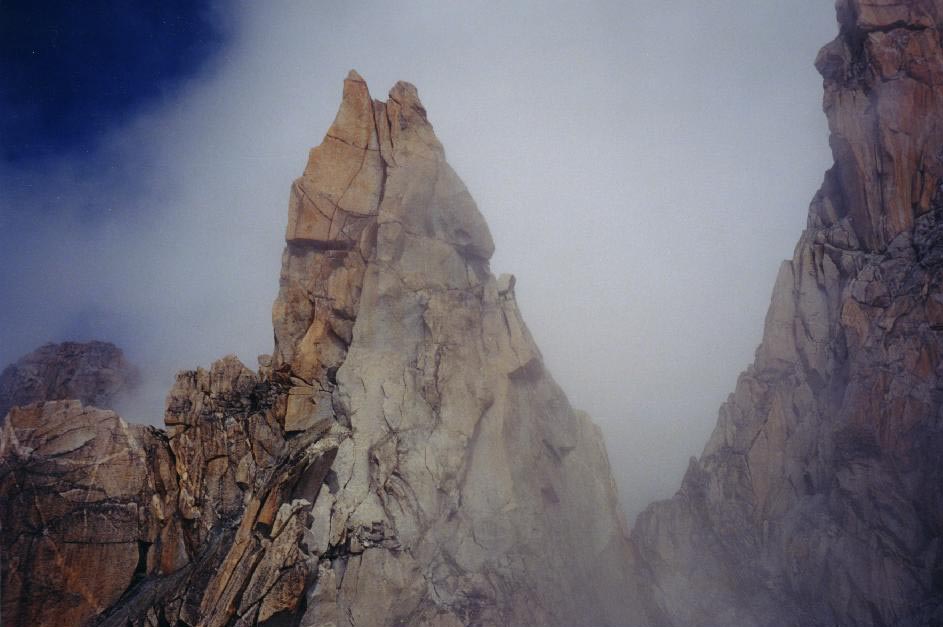 One of the pillars (not part of the route) near the top of the Minarette. (Click on the picture
for a larger version.)
One of the pillars (not part of the route) near the top of the Minarette. (Click on the picture
for a larger version.)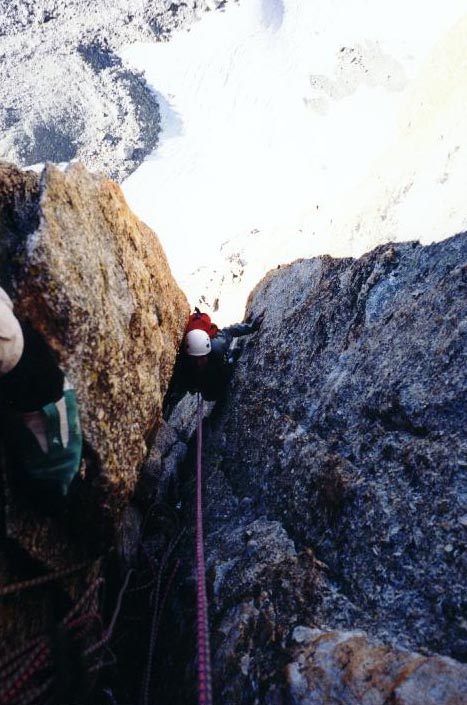
Most of the climbing was fun and aesthetic, however, on steep cracks and faces. The crux of the lower section was a steep crack right off of a belay. Pierre grunted quite a bit getting up it, and I almost fell when my foot slipped, but managed to get up it without a fall. Near the top of the shoulder is a section of A1 aid climbing that was the hardest part of the climb for me. It follows an overhanging arete, and although the pitons are close together, it taxed my strength to work my way up, pulling on quickdraws and slings, and I ended up clipping in and hanging from my harness several times to rest. Probably the finest pitch of the climb came almost at the top; a beautiful finger crack on a steep rough wall that required some strenuous laybacking and finger jams to overcome. It was a great way to finish up the route. Overall, there were about ten pitches of climbing. The hardest moves on the climb (other than the aid pitch) were probably 5.8, but the majority of the climbing was in the 5.6 to 5.7 range. The climbing was almost continuously interesting, and the views across the valley of the great north walls of the Argentiere cirque made for a breathtaking backdrop. It was easy to see why this climb had a place in Rebufatt's 100 finest routes.
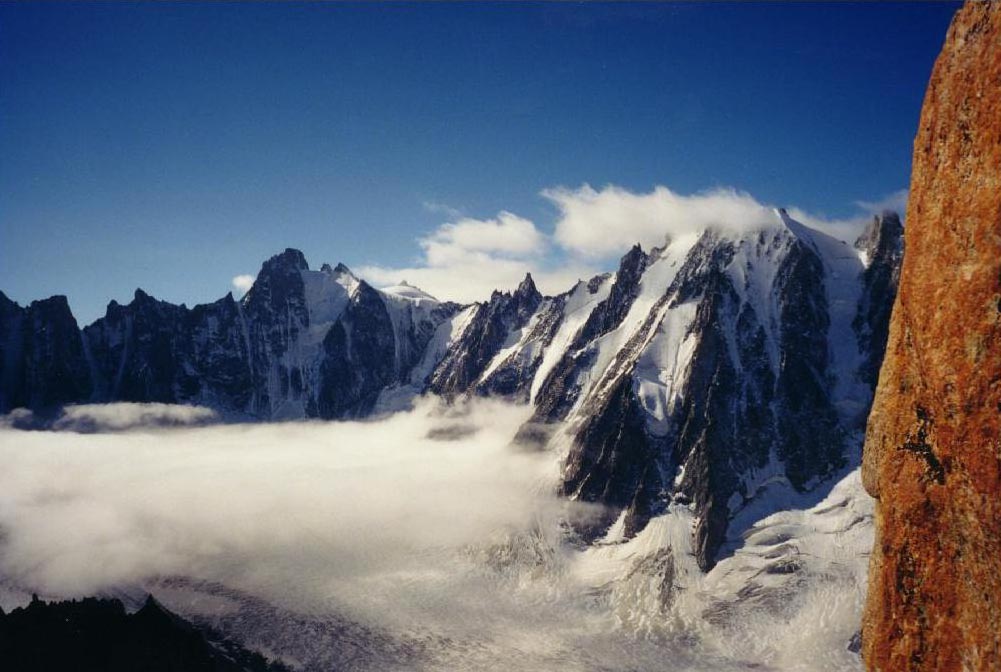 View of the Argentierre cirque from the Minarette. (Click on picture for larger version.)
View of the Argentierre cirque from the Minarette. (Click on picture for larger version.) After a day of rest, I was ready for more climbing. Francis and Pierre were both climbing with other clients, so I headed for the Chamonix Guides Company office in search of a guide to take me up some snow and ice routes. I had hoped to get Serge, the guide I had climbed the Chardonnay with two years ago, but he was on Mont Blanc with another client. As it turned out, I got his brother Franco instead. Franco is short, solid, with silver hair and a weather beaten face. He looks like he has spent a lifetime in the mountains. He has a great disposition and a friendly, encouraging attitude. We were to spend two days together. The first day we were climbing the Chere couloir on the triangle face of Mont Blanc du Tacul. The second day, we were going to climb the North Face of the Tour Ronde. Of the two climbs, the Chere couloir was more difficult, with some steep ice pitches of greater than 70 degrees. I wasn't too worried about it, however, because it was only about eight pitches long, and we would be climbing in pitches, belaying each other, rather than simul-climbing. Climbing in pitches had the dual virtues of being somewhat safer, and also allowed me to rest in between climbing.

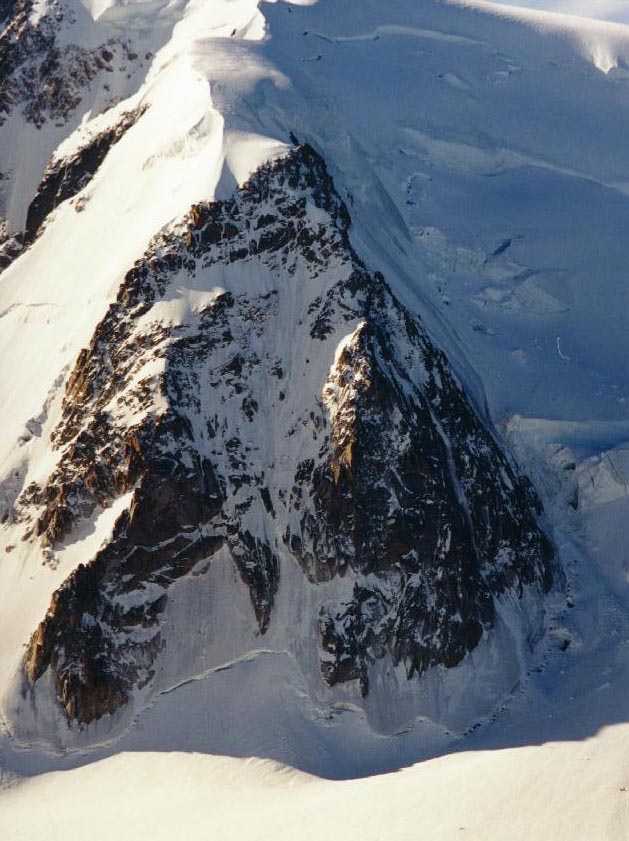 Mont Blanc du Tacul, and a close up of the Triangle. The Chere
Couloir is visible on the right side of the Triangle. (Click on pictures for larger versions.)
Mont Blanc du Tacul, and a close up of the Triangle. The Chere
Couloir is visible on the right side of the Triangle. (Click on pictures for larger versions.) We then shed our crampons and hiked across the glaciated Valle Blanche to the Torino hut. The hike was beautiful, passing beneath the Gervasutti Pillar and Grand Capucin, and other spectacular mountain scenery. We had some good views of the of the Dent du Geant and the Tour Ronde, our objective for the next day. Looking at it face-on, the North Face of the Tour Ronde looked steep and foreboding. Knowing that most of it would be climbed without belays, I began to get a bit anxious about climbing it. I still wasn't used to the Alpine method of simul-climbing, and wished that we could take our time climbing it in pitches. I was also still a little worried about the effects of altitude, but I seemed to be doing much better than before, and had little trouble cruising up the slopes to the Torino hut.
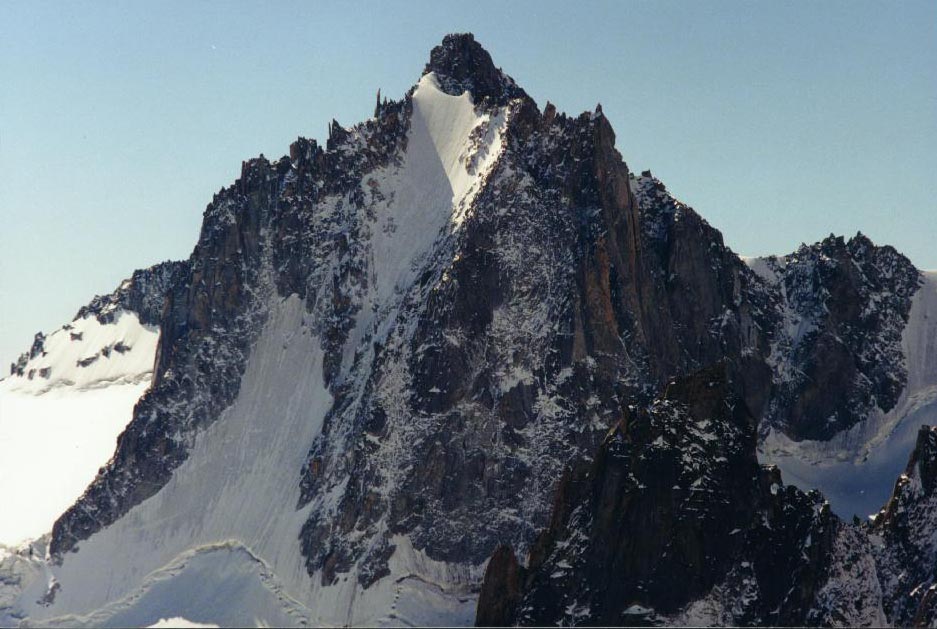 Tour Ronde North Face (Click on picture for larger version.)
Tour Ronde North Face (Click on picture for larger version.) 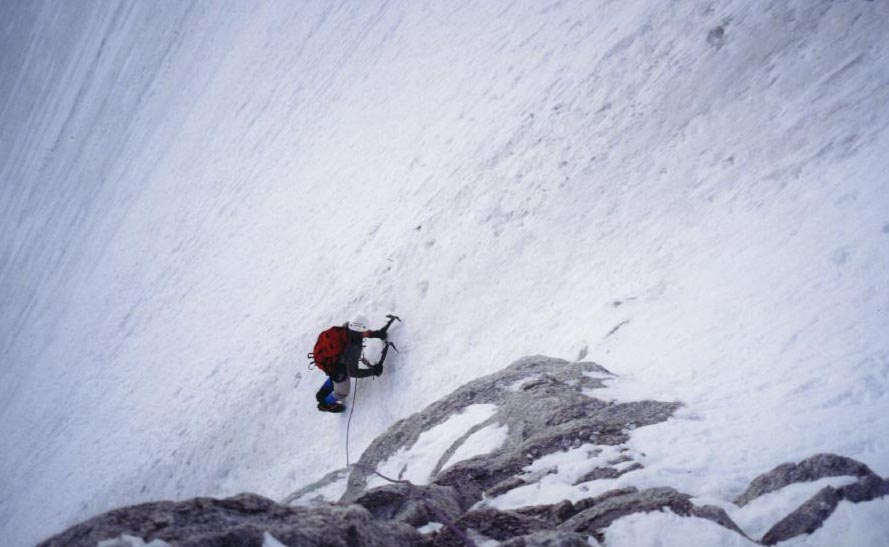 Approaching the rock bands on the Tour Ronde N. Face (Click on picture for larger version.)
Approaching the rock bands on the Tour Ronde N. Face (Click on picture for larger version.)The descent was somewhat unpleasant, down loose rocky ridges and gullies filled with wet snow and dirty ice. I was relieved to get down to the glacier again and we trekked happily back to point Helbronner and the cable car which would take us back to Chamonix. Overall, I had been extremely happy with my two day trip in the mountains. Both the Chere couloir and the N. face of the Tour Ronde had been fun climbs. They had given me some experience moving quickly over snow and ice, and had provided me with some confidence regarding my ability to function at altitude.
Although I was a little tired from my two day outing, I felt well enough to head up for the South face of the Aiguille du Midi the next day. The Rebuffat route on the S. face is a must do climb for anyone visiting the Alps, and the weather was perfect, warm and sunny. I met Francis at about 9:30, and we caught the tram up to the top of the Aiguille du Midi. We got to the base of the Rebuffat route and found three other parties there also. The weather was good, and we were not in any particular hurry, however, so the other people didn't really bother me too much. On such a good day, I had expected a classic such as the Rebuffat route to be a bit crowded. Finally, we headed off, leaving our packs with our boots and crampons at the base, as we were planning on rappelling back down the route when we were done. The climbing was a lot of fun. The rock was excellent and the granite provided excellent traction for my sticky rubber clad feet. The moves were not difficult, maybe 5.7+ at the hardest. The most difficult thing about the climb was co-existing with the numerous other climbers on the route. The belays were crowded and trying to keep clear of other parties' ropes and gear was sometimes more challenging than the climbing. In spite of this, the route was interesting and the views across the valley were beautiful. I was a bit disappointed when we reached the top and it was time to rappel down.
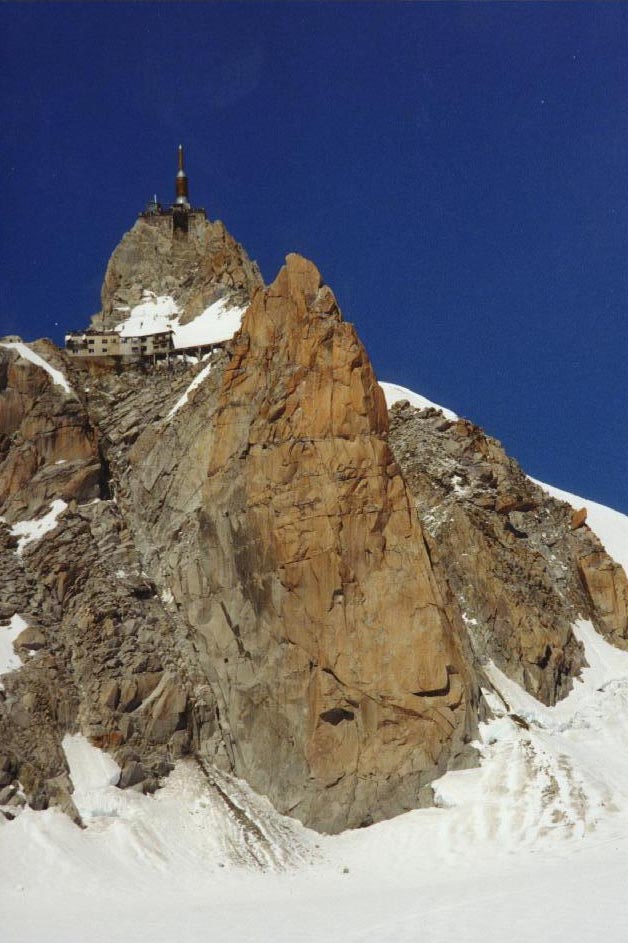 Aiguille du Mid South Face (Click on picture for larger version.)
Aiguille du Mid South Face (Click on picture for larger version.) I felt I was ready now for a second try at the Kuffner Ridge on Mount Maudit. I had not had any hint of the altitude sickness that had plagued me on my first attempt, and I was feeling more confident in my abilities as well. I called Franco, and he agreed to guide me up the ridge. We spent the night in the Cosmiques hut rather than the Fourche hut. I had some reservations about spending the night at a hut that was relatively far from the start of the route, but Franco insisted that we would rest much better and that the lengthened approach would not add overly much to the difficulties of the climb. I deferred to his judgement, and we took the 4:30 cable car up to the Aiguille du Midi and made the short hike over to the Cosmiques hut. The hut was crowded but comfortable, and the food was excellent. Eating a four course dinner, I was glad we were not munching cold food at the cramped Fourche bivi hut. We got to bed early, and were up at 3:00 the next morning. We then took the familiar hike across the Valle Blanche, this time by the light of our headlamps. The approach was monotonous, as it was very dark, and there was no scenery to look at, just the immediate area lit by our headlamps and the steady ups and downs of the glacier. We hiked quickly, as there were few distractions and we were eager to get onto the route.
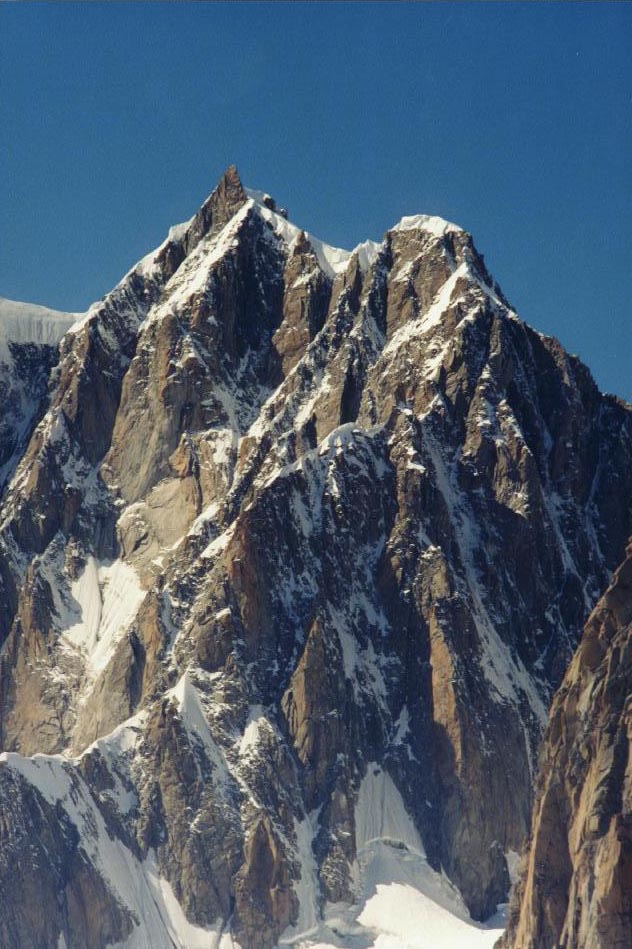 Mount Maudit's Kuffner Ridge viewed from the summit of the Tour Ronde. (Click on picture
for larger version.)
Mount Maudit's Kuffner Ridge viewed from the summit of the Tour Ronde. (Click on picture
for larger version.) About dawn, we caught up with another team of climbers. They had spent the night at the Fourche hut and said that it was extremely crowded and uncomfortable, with people sleeping on and under the tables and benches. Hearing this, I was glad that we had opted for the luxury of the Cosmiques hut, even though it added a considerable approach to our climb. We passed several other parties as well, moving quickly and simulclimbing while they belayed every pitch. Franco would weave the rope in and out of rock horns as we climbed, and the conditions of the snow and ice were very good, so I felt reasonably comfortable about moving together for most of the way. The climbing was not overly difficult, but it was relatively sustained. There were sections of steep snow and ice, and also sections of rock, which we climbed with our crampons. To me, the most intimidating portions of the climb were those sections where we had to traverse steep, narrow "knife edge" ridges. It was like walking a balance beam, and there was generally no opportunity to use your axe for support. I took these sections slowly and carefully, placing each step deliberately, and being extra careful not to tangle up my crampons. After several sections of steep rock and steep ice, we cleared the technical section and were left with a long, corniced ridge that curved steadily to the sharp summit of Mount Maudit. I could feel the thinness of the air, and after a while it was quite difficult to continue the constant upward stepping. We were rewarded by amazing views, however, that took my mind off of my fatigue. The mountains were beautiful in the pale, early morning light, and from our vantage point on the high ridge line, we could see not only the mountains of the Mont Blanc Massif, but also the other alpine ranges behind them. The distant mountains were layered one behind another, each successive peak becoming less and less distinct to our vision until they seemed like ghosts.
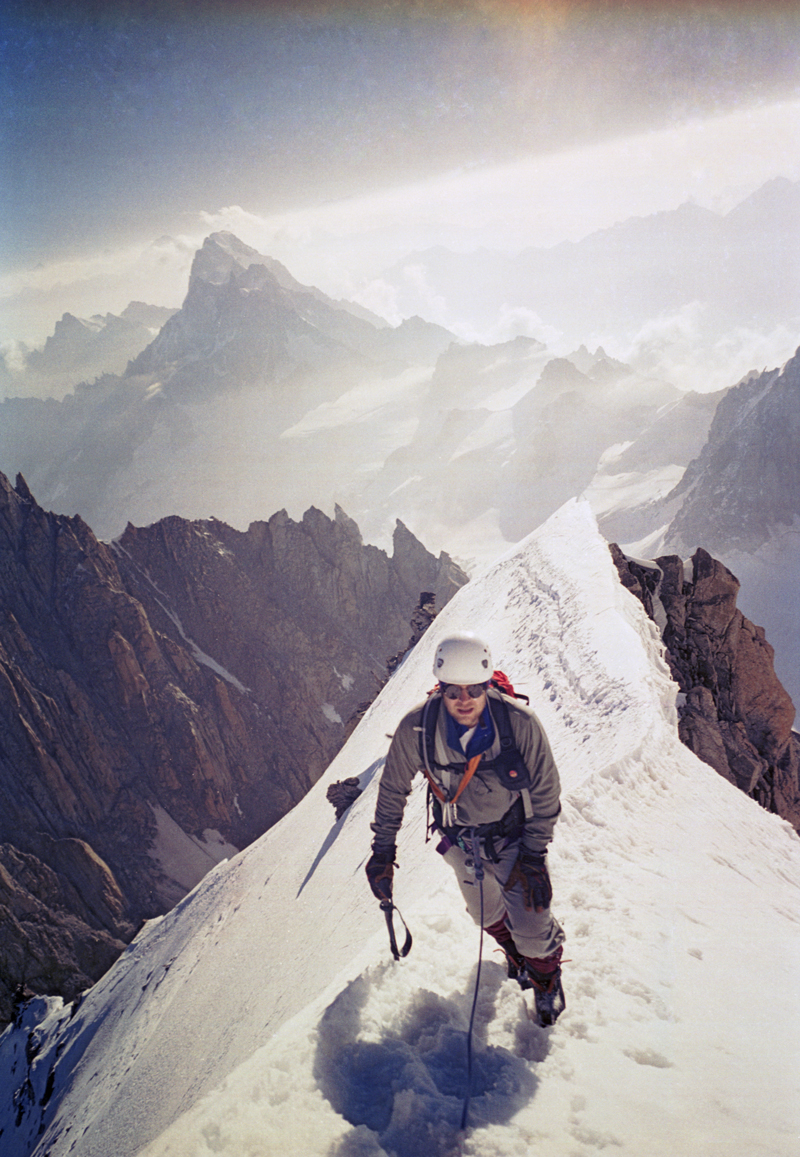 Approaching the summit of Mt. Maudit (Click on picture for larger version.)
Approaching the summit of Mt. Maudit (Click on picture for larger version.) The Kuffner ridge had more than lived up to my expectations. It was challenging but not
extremely difficult; it provided interesting climbing on rock and snow and ice; and the scenery and
positions were amazing. Climbing this route seemed to provide me with a bit of everything that I
love about climbing; challenge, beauty, variety, and fear, in just the right proportions. I was very
happy that I had come back to climb this route. It was a great experience and a perfect way to
end my visit to the Alps. The next day, I was back in the real world, headed for London for a
string of business meetings. It had been a great vacation, and I had been able to get in a lot of
climbing. I was tired but happy, thinking of home and family, but also dreaming about future
challenges. The Gervasutti Pillar, the Aiguille Noir du Peuterey, and the Aiguille Verte had all
caught my eye, and I had already marked them in my guidebooks as potential ventures on my next
trip to Chamonix.
BACK TO CLIMBING/BACKPACKING MAIN PAGE